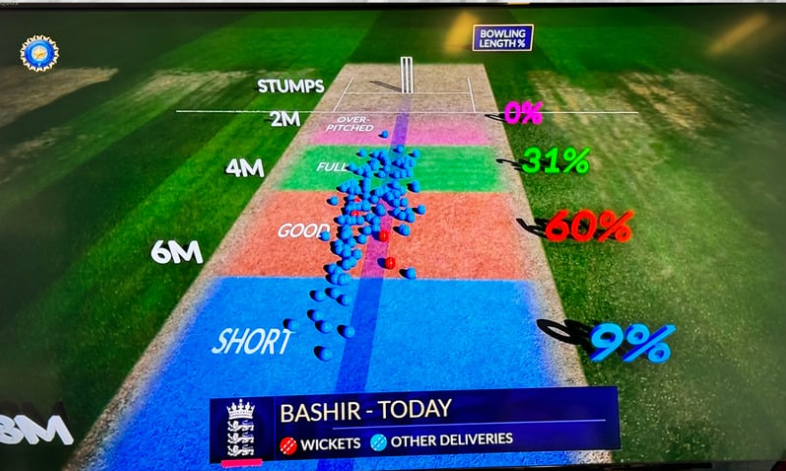India’s math problem and Shoaib Bashir
Notes from day two of the fourth Test at Ranchi

Ollie Robinson started the day like late career Bradman. This meant that either the wicket was a lot better than we thought, or he was actually using some of the last good times of the wicket. India finally got a quick end to the innings, but after England had stretched it out massively.
India came to the wicket and for a while, it looked like they would get near par. But once we saw crumbs of the wicket flying up when the ball hit the crack, it was more a case of how close they could find themselves. When Jaiswal was dismissed, India lost their mojo. Even when the ball got soft and they started to slow the collapse down, they couldn’t put the pressure back on England.
Game maths time. India need to be chasing less than 200. The new ball is due in seven overs, so say they get 20 runs off that (as England might bowl dry). That means they have three wickets against the new ball to get at least another 30 runs, which will have them 84 runs behind.
That means they have to hope Ashwin and Jadeja run through England, or the touring team Bazballing themselves into 110 all out. This means that for India to win, England need to play a big part in their third wicket collapse. Because if it is the wicket, India will still have to bat on it at the end. India’s real chance is an 80-100 added runs. But even if they do that, it might need to come quick, because otherwise, the pitch will only deteriorate more.
The math is not really on India’s side.
Shoaib Bashir’s return (JK)
One of the issues for the England spinners so far is no matter how good their best ball is, their worst has been quite poor. Shoaib Bashir might be the most accurate out of England’s four spinners, so he could keep the pressure on. He ended up with a higher economy than Hartley, but for much of the day was harder to score off.

In fact, the easiest way to make runs from his bowling today was hitting the ball back to him, because he is not great at fielding off his own work. Sometimes, young bowlers are too focused on bowling and they don't know how to get in a good position.
Shoaib Bashir's 31-over spell of 4-83 is, according to @CricViz data:
— Andy Zaltzman (@ZaltzCricket) February 24, 2024
- The longest spell by an England bowler since 2013 (Swann, 6-90 in a 32-over spell v NZ, Leeds)
- The longest spell by any bowler in a Test in India since 2005 (Kumble, 7-63 in 38 v Pakistan, Kolkata)
This is his pitch map today. It’s pretty good on line, and I thought it was quite interesting on length. You can see how he dropped short quite a few times. But that's okay on a wicket like this because the ball was keeping low and batters have not been in a position to hit those.

I asked CricViz today because Shoaib Bashir was bowling over the wicket to Yashasvi Jaiswal. We don't see that often anymore because once DRS came in, it made sense for an off-spinner to pitch every ball on off stump or middle stump to try and get LBWs, bowleds, caught-behinds and caught at slips. When you're bowling over the wicket, naturally the chances of getting an LBW or bowled reduce.

CricViz looked this up for Shoaib Bashir in county cricket. So it wasn't something he usually does. It was a good tactic today because Jaiswal is a brilliant player of off-spin in particular, and bringing in a different angle in play made sense.

Jaiswal's shuffle (JK)
There was a point in this innings where Jaiswal was facing Ollie Robinson, who was aiming at a crack outside off stump to get some movement. The ball after Robinson induced an edge behind to Foakes from Jaiswal, the left-hander came down the wicket.

England, Pakistan and New Zealand were three teams that I first noticed that used this tactic against seam bowling to try and disrupt the ball when it's wobbling (not the case today, but the same basic principle). Pakistan don't shuffle as much, but they use the crease in a Javed Miandad-style. New Zealand use a combination of batting out of their crease and coming down the wicket.
Everytime Jaiswal had an issue, he did that. Joe Root does it more than anyone else. He also plays back further than other players sometimes. This means bowling a consistent length to Root is very tough. We saw Rohit Sharma do this in the World Cup, and occasionally in this series as well.

Ollie Pope is one of the better players while doing it, although he got out doing it in the first-innings. In Test cricket, I would say Ben Stokes and Jos Buttler are pioneers of this. Their rationale behind that was probably that they wanted more pace on the ball at times.
Tom Hartley’s all-round run (SAK)
Tom Hartley was quite accurate, and he offered a lot more control compared to his first outing. He also bowled a lot less bad balls. The Sarfaraz wicket was massive in context of the game, because things could have been a lot different if he got going. Bashir getting Jadeja was also extremely crucial, because Jadeja had scored 41 off 69 against Hartley in the series without being dismissed.

Hartley has the most wickets by anyone in the series. He has also bowled the most overs - 60 overs more than the second-most, Rehan Ahmed. But this time, he will have the pressure of bowling his team to victory as the main spinner. Nobody expected that from him in the first Test.

You also have to consider that Hartley has played on far less spin-friendly wickets as compared to the likes of Tahir, Harmer, o'Keefe, Leach and Murphy.

He has added value with the bat too. 12 visiting spinners in history have taken 10 wickets & scored 100 runs in a series in India, and only four in the 21st century. Moeen Ali was basically a batting all-rounder in 2016, so it is not quite the same role. Adil Rashid averaged 14 with the bat & 37 with the ball. Mitch Santner is probably the closest in terms of role, he averaged 26.5 with the bat but 52.4 with the ball.

India’s batting challenge (SAK)
India have won just one game after being behind in the 2nd innings in the last 10 years, which was basically equal (1 run behind at Delhi vs Aus last year). The current lead is already lower than Pune 2017 & Chepauk 2021, so it would be interesting to see how much more they can reduce the deficit.

WinViz, CricViz's win predictor, currently has India at a 37% chance of winning this Test. Also, note that this is a wicket where scoring quickly has not been easy.

Yesterday, I thought that playing against the new ball would be challenging on this wicket. India were at their best when Jaiswal and Gill were in the middle, and that was against the new ball. After a bit of collapse in the middle, the partnership between Jurel & Kuldeep has brought them back to a slightly more respectable position.

Kuldeep Yadav is dismissed once every 44 balls in Test cricket, which is pretty handy for a number 9 or 10. In fact, he averages 26.25 for Uttar Pradesh in the Ranji Trophy .

We know he is good at opening the face of the bat and tucking the ball off his hip. Dhruv Jurel hit a pretty strong six down the ground, and was also able to play a ball that rolled along the ground.

Although the ball got soft when these two were batting and that made things relatively easy for them, these are still very solid control percentage figures on a wicket which had some cracks and a few balls kept low.




